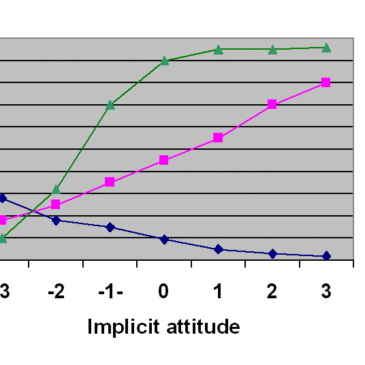Social psychologists often demonstrate that explicit measures of attitudes (i.e., direct inquiries about one’s thoughts and opinions) are biased and unreliable (Holtgraves, 2004). Therefore, researchers have developed various implicit methods for measuring attitudes. This week’s ASHES reviews a study that examined how implicit and explicit attitudes about smoking predict the probability of being a smoker (Perugini, 2005).
Methods
- Perugini recruited 35 women and 13 men on campus; of these participants, 25 were smokers and 23 non-smokers.
- Participants completed:
- Implicit Association Test (IAT) measuring response times to associations between the concepts, smoking and exercise, and the attributes, pleasant and non-pleasant.
- An explicit measure of smoking-related attitudes – This measure contained questions about smoking-related attitudes on 11 bipolar scales (i.e., bad – good, harmful – harmless, etc.).
- Researchers computed a logistic regression model to examine the ability of explicit and implicit attitudes individually and jointly to predict whether the participants were smokers.
Results
- The central tendencies (means and medians) of both smokers and non-smokers displayed negative implicit and explicit attitudes toward smoking.
- Smokers compared to non-smokers demonstrated significantly less negative implicit (F (1, 47) = 8.17, p < .01) and explicit (F (1, 47) = 31.77, p <.01) attitudes toward smoking. However, after controlling for the explicit attitudes, implicit attitudes were not related to smoking status.
- A logistic regression model revealed that a measure combining implicit and explicit attitudes improved the overall prediction beyond that of the individual attitudes (R2 change = .5.2%, χ2 = 3.2, p =.07). Figure 1 depicts this interactive pattern by extrapolating the observed regression model to standardized values ranging from -3 to +3 standard deviations around the mean. Implicit attitudes taken alone do not predict being a smoker. However, even a slight increase in implicit attitude score when combined with a positive explicit attitude score sharply increased the probability of being a smoker.

Figure. Interaction between implicit and explicit attitudes in predicting smoking behavior (adapted from Perugini, 2005). Click image to enlarge.
Limitations
- Although some consider IAT to be the most reliable procedure for measuring implicit attitudes, there are methodological issues that might detract from its validity. For example, some research suggests that familiarity, salience and knowledge of cultural norms can influence the results of the IAT (Houben & Wiers, 2007) and obscure interpretation.
- The correlational and retrospective design of this study make it difficult to interpret causality.
- The study’s small sample size limits the generalizability of the results.
- The interactive pattern was not statistically significant (p < .07).
Conclusion
This study contributes to our understanding of the interplay between implicit and explicit attitudes in predicting smoking status. The main finding is that a combination of less negative explicit attitudes toward smoking and less negative implicit smoking-related associations is related to an estimated greater likelihood of being a smoker. Future studies should use methods other than the IAT to measure implicit attitudes to complement the findings of this study. Longitudinal studies will help to investigate the effect of implicit and explicit attitudes on smoking behavior prospectively rather than retrospectively.
-Julia Braverman
References
Holtgraves, T. (2004). Social desirability and self-reports: Testing models of socially desirable responding. Personality and Social Psychology Bulletin, 30(2), 161-172.
Houben, K., & Wiers, R. W. (2007). Are drinkers implicitly positive about drinking alcohol? Personalizing the alcohol-IAT to reduce negative extrapersonal contamination. Alcohol and Alcoholism, 42(4), 301-307.
Perugini, M. (2005). Predictive models of implicit and explicit attitudes. British Journal of Social Psychology, 44(1), 29-45
What do you think? Please use the comment link below to provide feedback on this article.




